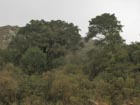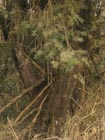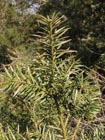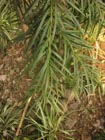Conservation Status

Podocarpus parlatorei
Pilger 1903
Common names
Pino del cerro.
Taxonomic notes
Syn: Podocarpus angustifolius Parl. 1868 non Griseb. 1866; Nageia angustifolia (Parl.) Kuntze 1891 (Farjon 1998).
Description
Shrubs, or trees to 20 m tall and 150 cm dbh, with a broad crown. Bark brown, weathering to gray, becoming slightly fissured on larger stems. Twigs slender, round, with finely grooved below slightly raised leaf bases, yellow-green, turning brown with age. Leaves dimorphic; those on juvenile plants ca. 120 × 5 mm; those on mature plants ca. 40-80 × 2-3 mm, straight or slightly falcate, short-petiolate with slightly revolute margins; apex acute; green above, lighter green below. Midrib on upper side of leaves a shallow groove fading towards the apex; on lower side a narrow ridge, also fading towards apex. Stomata on lower side of leaves, very small, in many discontinuous lines. Pollen cones axillary, in clusters of 3-6 or more, grouped on slender angular stalks 5-15 mm long; individual cones 5-10 × 1.5-2 mm long, wih triangular microsporophylls triangular having minutely denticulate margins. Seed cones axillary, appearing with new leaves, solitary on 3-8 mm long peduncles; receptacles have 2-3 fused, swollen bracts, 4-5 mm long, red when mature. Seeds globose, 5-6 × 4-5 mm, including the epimatium (Farjon 2010).
Distribution and Ecology
Argentina and Bolivia (Farjon 2010); although formerly reported from Peru, those records are inaccurate (Farjon and Filer 2013). Found in montane Yungas forests at elevations of 1200 to 3000 m (Quiroga et al. 2012). In its northern range, P. parlatorei typically occurs beneath the canopy of angiosperms such as Alnus acuminata, Cedrela lilloi, and Juglans australis, but near its southern range limit in Argentina it often occurs in pure stands (Morales et al. 1995). Ecologically, it typically regenerates after severe disturbances as a cold-tolerant pioneer species; it rarely regenerates in closed canopy forests, but is a long-lived species (Arturi et al. 1998, Carilla and Grau 2010, Quiroga et al. 2012). This pattern, of an early seral species that persists in late seral forests due to a long lifespan, is common in conifers. P. parlatorei, like other species in the genus, is wind-pollinated but relies primarily upon animals for seed dispersal; these include guans (Penelope sp.), the band-tailed pigeon (Patagioenas fasciata), and the hog-nosed skunk (Conepatus chinga) (Quiroga and Gardner 2013).
The conservation status rangewide is "near threatened". In Argentina and Bolivia, much of the species' range is located within protected areas, but the most genetically variable subpopulations in the southern range extent are not in protected areas (Quiroga and Premoli 2007). Although the species was at one time exploited for timber production, the primary current threat is habitat loss, mainly due to fires set to maintain grasslands for livestock production. Timber production is also ongoing, but at a small scale (Quiroga and Gardner 2013).
Distribution data from GBIF (2019).
Remarkable Specimens
An ecological study in the Las Yungas Biosphere Reserve, Argentina, found trees with up to 169 rings. The ages were not crossdated due to issues with false and missing rings, but the authors provide evidence that the age estimate is likely correct to within 5 years (Carilla and Grau 2010).
Ethnobotany
Contemporary use is primarily small-scale and local; the species is a source of firewood and varied domestic uses. It is used as live fencing around houses and pastures (Quiroga and Gardner 2013).
Observations
Everything from seedlings to old trees can be seen on the "Ruta del Che" besides the gravel road between Vallegrande and La Higuera, Bolivia (Burkhard Witt email 2019.02.28).
Remarks
Curiously, this is one of only 5 conifer species listed on CITES Appendix I, which prohibits all commercial international trade in the species. Yet, in Bolivia, it is regarded as the least-threatened of all their native conifers (Meneses and Beck 2005). This is a case that points up the benefits of systematic, range-wide conservation status assessments performed using a standard protocol, as is done by IUCN.
Citations
Arturi, M. F., H. R. Grau, P. G. Aceñolaza, and A.D. Brown. 1998. Estructura y sucesión en bosques montanos del Noroeste de Argentina. Revista de Biología Tropical 46:525-532 (cited by Quiroga and Gardner 2013).
Carilla J. and Grau, H.R. 2010. 150 years of tree establishment, land use and climate change in montane grasslands, northwest Argentina. Biotropica 42:49-58. https://doi.org/10.1111/j.1744-7429.2009.00565.x.
Farjon, Aljos. 2010. A Handbook of the World's Conifers. Leiden, Netherlands: Brill Academic Publishers.
Farjon, A. and D. Filer. 2013. An Atlas of the World's Conifers: An Analysis of their Distribution, Biogeography, Diversity, and Conservation Status. Leiden, Netherlands: Brill Academic Publishers.
GBIF. 2019. GBIF occurrence download. https://doi.org/10.15468/dl.tduyrh, accessed 2019.05.08.
Meneses, R. I., and S. Beck. 2005. Especies amenazadas de la flora de Bolivia. La Paz: Herbario Nacional de Bolivia. http://www.fundesnap.org/files/lista_flora_amenazada_bolivia_2005.pdf, accessed 2019.06.24, now defunct.
Morales, J. M., M. Sirombra, and A. D. Brown. 1995. Riqueza de árboles en las Yungas argentinas. P. 163-174 in A. D. Brown and H. R. Grau (eds), Investigación, conservación y desarrollo en las selvas subtropicales de montaña (cited by Quiroga and Gardner 2013).
Quiroga, M. P. and A. C. Premoli. 2007. Genetic patterns in Podocarpus parlatorei reveal the long-term persistence of cold-tolerant elements in the southern Yungas. Journal of Biogeography 34:447-455 (cited by Quiroga and Gardner 2013).
Quiroga, M. P., S. Pacheco, L. R. Malizia, and A. C. Premoli. 2012. Shrinking forests under warming: evidence of Podocarpus parlatorei (pino del cerro) from the Subtropical Andes. Journal of Heredity 103(5):682-689 (cited by Quiroga and Gardner 2013).
Quiroga, P. and M. Gardner. 2013. Podocarpus parlatorei. The IUCN Red List of Threatened Species 2013: e.T32019A2808150. http://dx.doi.org/10.2305/IUCN.UK.2013-1.RLTS.T32019A2808150.en, accessed 2019.05.08.
See also




